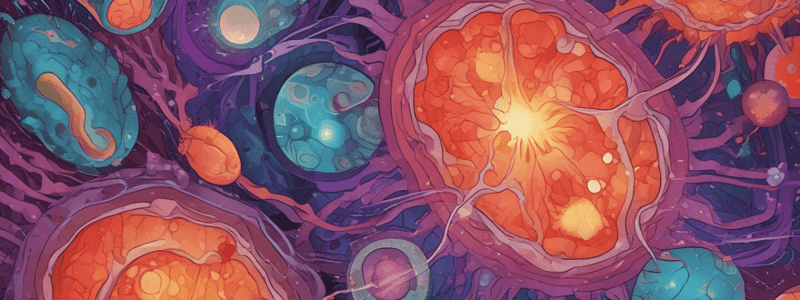Podcast
Questions and Answers
What is the main difference between ischemia and hypoxia?
What is the main difference between ischemia and hypoxia?
- Ischemia generates more ATP than hypoxia
- Ischemia is a type of hypoxia
- Ischemia interferes with the delivery of substrates for glycolysis (correct)
- Hypoxia is a type of ischemia
What is the primary effect of anaerobic glycolysis in hypoxic cells?
What is the primary effect of anaerobic glycolysis in hypoxic cells?
- Increased protein synthesis
- Increased ATP production
- Depletion of glycogen stores (correct)
- Reduced lactic acid accumulation
What is the result of paralysis of ion pumps in hypoxic cells?
What is the result of paralysis of ion pumps in hypoxic cells?
- Exit of Na+ and influx of K+
- Reduced protein synthesis
- Increased ATP production
- Influx of Na+ and exit of K+ (correct)
What is the consequence of reduced protein synthesis in hypoxic cells?
What is the consequence of reduced protein synthesis in hypoxic cells?
What type of insult can result from extreme heat or cold?
What type of insult can result from extreme heat or cold?
What is a common target of cell damage?
What is a common target of cell damage?
What is the result of ischemic injury in tissues?
What is the result of ischemic injury in tissues?
What is a type of cell injury that can result from dietary insufficiency?
What is a type of cell injury that can result from dietary insufficiency?
What happens when the limits of adaptive capability are exceeded?
What happens when the limits of adaptive capability are exceeded?
What is reversible cell injury characterized by?
What is reversible cell injury characterized by?
What type of injurious agent can cause cell injury?
What type of injurious agent can cause cell injury?
What factor influences the severity of cell injury?
What factor influences the severity of cell injury?
Which cell type is highly susceptible to ischemic damage?
Which cell type is highly susceptible to ischemic damage?
What is ischemia?
What is ischemia?
What can interfere with oxidative phosphorylation?
What can interfere with oxidative phosphorylation?
What happens with continuing damage?
What happens with continuing damage?
What is the primary cause of cellular swelling in hypoxic injury?
What is the primary cause of cellular swelling in hypoxic injury?
What is the hallmark of hepatic fatty change?
What is the hallmark of hepatic fatty change?
What is the fate of the cell if oxygen is restored after a period of hypoxia?
What is the fate of the cell if oxygen is restored after a period of hypoxia?
What is the primary mechanism of cell death in ischemic injury?
What is the primary mechanism of cell death in ischemic injury?
What is the significance of measuring serum levels of creatine kinase and troponin?
What is the significance of measuring serum levels of creatine kinase and troponin?
What is the consequence of massive influx of calcium into the cell?
What is the consequence of massive influx of calcium into the cell?
What is the common feature of free radicals?
What is the common feature of free radicals?
What is the consequence of reduced ATP synthesis and mitochondrial damage?
What is the consequence of reduced ATP synthesis and mitochondrial damage?
Flashcards are hidden until you start studying
Study Notes
Cellular Injury
- Cellular injury occurs when the limits of adaptive capability are exceeded and no adaptive response is possible.
Types of Cell Injury
- Cell injury can be divided into reversible and irreversible (cell death) types.
Reversible Cell Injury
- Occurs when the injurious agent is mild or short-lived, and functional and morphologic changes are reversible.
- Cell injury becomes irreversible with continuing damage, leading to cell death.
Types of Injurious Agents (Causes of Cell Injury)
- Hypoxia
- Physical agents (trauma, burns, irradiation)
- Chemical agents (poisons, drugs, alcohol)
- Infectious agents
- Immunological reactions
- Genetic derangement
- Nutritional imbalances
- Aging
Factors Influencing Severity of Injury
- Type and severity of injurious agent
- Duration of exposure
- Type of affected cells (e.g., neurons, myocardial cells, skeletal muscles)
Types of Insult
Hypoxia
- Reduced oxygen
- Ischaemia (local or systemic)
- Hypoxaemia (inspired oxygen too low, diffusion barrier abnormal, or insufficient carrying capacity in blood)
- Interference with oxidative phosphorylation (e.g., cyanide poisoning)
Chemical Insults
- Drugs (e.g., paracetamol overdose)
- Other chemicals (e.g., alcohol, cigarette smoke)
Infections
- Eukaryotes (Fungi, Protozoa)
- Prokaryotes (Bacteria, Rickettsiae, Chlamydiae)
- Viruses (DNA, RNA)
Physical Insults
- Direct physical effects (extreme heat or cold, sudden changes in pressure, electrical currents)
Immune Insults
- Humoral
- Cell-mediated
Nutritional Insults
- Dietary insufficiency
- Dietary excess
Principle Structural Targets for Cell Damage
- Cell membranes (plasma membrane, organellar membranes)
- DNA
- Proteins (structural, enzymes)
- Mitochondria (oxidative phosphorylation)
Examples of Cell Injury and Necrosis
Ischemic and Hypoxic Injury
- Ischemia is the most common cause of cell injury in clinical medicine.
- Ischemia injures tissues faster than hypoxia due to lack of substrate delivery for glycolysis.
Hypoxia and Ischemia
- Loss of ATP generation leads to failure of many energy-dependent systems.
- Anerobic glycolysis leads to lactic acid accumulation and cell swelling.
- Reduction in protein synthesis and altered metabolism occur.
Pathogenesis of Cell Injury - Hypoxia
Reversible
- Loss of ATP
- Failure of Na/K pump leading to cell swelling
- Anaerobic metabolism and increased lactic acid
- Reduced protein synthesis and altered metabolism
Irreversible
- Massive intra-cytoplasmic calcium accumulation
- Activation of multiple degradative enzymes
- Lethal cell damage
Pathogenesis of Cell Injury - Non-Ischaemic
- Reduced ATP synthesis/mitochondrial damage
- Loss of calcium homeostasis
- Disrupted membrane permeability
- Free radicals
Free Radicals
- Highly reactive, unstable chemicals associated with cell injury in many settings.
- Free radical generation occurs through various mechanisms.
Studying That Suits You
Use AI to generate personalized quizzes and flashcards to suit your learning preferences.




